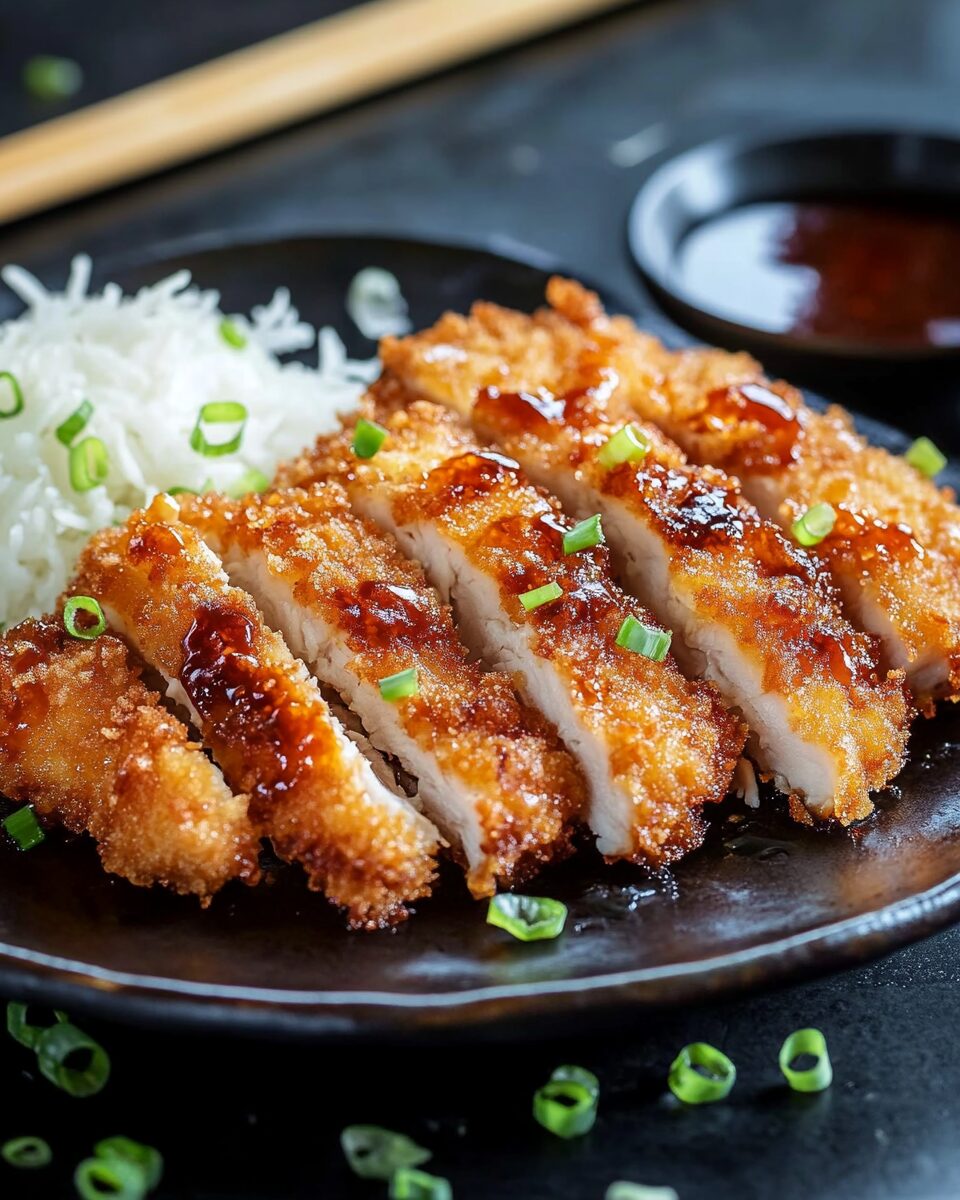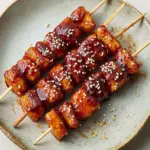These tender and golden-fried chicken cutlets are a staple in Japanese cuisine and bring serious satisfaction with every bite. Known as Chicken Katsu, this dish is made by breading chicken in light and airy panko breadcrumbs before deep-frying to crispy perfection.
What makes this recipe especially magical is its contrast — juicy chicken inside and an ultra-crunchy crust outside. Paired with tangy, umami-rich tonkatsu sauce and a fresh cabbage salad, it’s no wonder this meal is a favorite across homes and bento boxes alike. Whether you’re cooking for family or just craving something crispy, Chicken Katsu is a go-to comfort food that never disappoints.
Full recipe:
Ingredients:
-
1 boneless, skinless chicken breast (approx. 9.5 oz / 270 g)
-
½ tsp kosher salt
-
⅛ tsp freshly ground black pepper
-
3 Tbsp all-purpose flour
-
1 large egg
-
½ Tbsp neutral oil (for the egg)
-
1 cup panko breadcrumbs
-
3 cups neutral oil (for deep frying)
For Serving:
-
Tonkatsu sauce (store-bought or homemade)
-
Finely shredded green cabbage (optional)
-
Tomato slices (optional)
-
Japanese sesame dressing (optional)
Directions:
-
Butterfly the chicken breast using a sharp knife, slicing horizontally without cutting all the way through, and open it like a book.
-
Pound to an even thickness of ¼ to ½ inch.
-
Season both sides with salt and pepper.
-
Prepare three separate bowls: flour, whisked egg mixed with oil, and panko.
-
Dredge chicken in flour, then coat in the egg mixture, and finally press into panko until fully coated.
-
Heat oil in a deep pot to 340ºF (170ºC).
-
Fry one piece at a time for 3 minutes, flipping halfway, until golden brown and crispy.
-
Drain on a wire rack or paper towels.
-
Slice into strips and serve with tonkatsu sauce and sides.
Prep Time: 20 minutes | Cooking Time: 10 minutes | Total Time: 30 minutes
Kcal: 474 kcal | Servings: 2
A Brief History of Katsu in Japan
The concept of katsu was introduced to Japan in the late 19th century, inspired by European-style cutlets such as the French côtelette or the Austrian schnitzel. Initially, it was made with pork and referred to as tonkatsu. As the dish became more popular, variations using chicken, beef, and even seafood started to emerge.
Chicken Katsu gained popularity due to its lighter flavor and leaner protein. It quickly found a niche among those who preferred chicken over pork, and it became especially loved by children and health-conscious eaters. Today, it’s one of the most common forms of katsu served across Japan and internationally.
Cultural Significance in Japanese Cuisine
Katsu dishes, including Chicken Katsu, are more than just everyday meals in Japan — they are often associated with good fortune and encouragement. The word katsu also means “to win” in Japanese, so these dishes are commonly eaten before important events like exams, job interviews, or sports competitions.
Moreover, Chicken Katsu is often featured in yōshoku (Western-influenced Japanese cuisine). This style blends Japanese flavors and techniques with Western dishes and has been popular since the Meiji Era. It reflects Japan’s historical openness to culinary fusion, making Chicken Katsu a dish that represents tradition, innovation, and a cross-cultural spirit.
Why Chicken Katsu is Loved Worldwide
Chicken Katsu has gained global appeal thanks to its simple yet satisfying flavor profile. The crispy exterior provides a satisfying crunch, while the inside remains juicy and tender. It’s a dish that suits a variety of tastes and dietary preferences, and it’s easy to serve with different sauces, sides, and grains.
Many international fans of Japanese food often encounter Chicken Katsu as a gateway dish. It’s accessible to those unfamiliar with traditional Japanese cuisine and works well in fusion dishes like Katsu Curry or Katsu Sandwiches (Katsu Sando).
Its versatility and universal appeal make it a hit not only in Japanese restaurants but also in home kitchens around the world.
Serving Suggestions and Side Dishes
Traditionally, Chicken Katsu is served with finely shredded raw cabbage and a drizzle of tangy tonkatsu sauce. The cabbage provides a refreshing crunch and acts as a palate cleanser between bites of rich, fried chicken. Often, a slice of tomato or lemon is added to brighten the plate visually and flavor-wise.
It’s also commonly paired with steamed Japanese rice and miso soup to make a complete meal. In some variations, it may be served over a bed of rice (katsudon) or topped with Japanese curry sauce (katsu kare).
Another popular serving method is placing the sliced cutlet inside a sandwich with soft milk bread, shredded cabbage, and sauce — this is known as the Katsu Sando, a hit in Japanese convenience stores and trendy cafes alike.
Sauce Pairings: More Than Just Tonkatsu Sauce
While tonkatsu sauce is the traditional pairing — a thick, sweet-savory sauce somewhat similar to Worcestershire — Chicken Katsu is quite versatile when it comes to condiments. Here are some common options:
-
Japanese mayonnaise – Rich and slightly sweet, great for a creamy contrast.
-
Spicy mustard – Adds a sharp kick to cut through the richness.
-
Ponzu – A citrus-based soy sauce that lends a light, tangy flavor.
-
Yuzu kosho – A fermented chili paste with citrus peel, for those who love spice and complexity.
These sauces allow Chicken Katsu to adapt to different regional tastes and personal preferences.
Common Variations of Chicken Katsu
Although the classic recipe remains unchanged in most homes and eateries, there are plenty of creative ways people like to customize Chicken Katsu:
-
Cheese-Stuffed Katsu – Chicken breast is filled with cheese before being breaded and fried.
-
Katsu Donburi (Katsudon) – The cutlet is simmered with a sweet-savory soy sauce, onions, and eggs, then served over rice.
-
Katsu Kare – Served with a rich Japanese curry, turning it into a hearty comfort meal.
-
Baked or Air-Fried Versions – For those avoiding deep frying, Chicken Katsu can be baked or air-fried while still achieving crisp results, especially when panko is pre-toasted.
-
Katsu Sando – A sandwich with crustless milk bread, cabbage, and sauce for an on-the-go meal or lunchbox.
These variations highlight the dish’s adaptability and the creativity it inspires among home cooks and chefs alike.
Tips for Making Perfect Chicken Katsu at Home
To achieve restaurant-quality Chicken Katsu, a few simple techniques can elevate the results:
-
Butterfly and Pound the Chicken Evenly – This ensures the meat cooks evenly and remains juicy.
-
Use Japanese Panko – Authentic panko gives the signature crunch. Toast it first if you’re baking.
-
Control Oil Temperature – Keep it around 340°F (170°C) for even frying and minimal oil absorption.
-
Add Oil to the Egg Wash – A small splash of oil helps the breading stick and creates a crispier coating.
-
Rest on a Rack, Not Paper Towels – This prevents steam from softening the crust.
By following these steps, anyone can master Chicken Katsu, even without professional culinary experience.
Nutritional Considerations
Although it’s a fried dish, Chicken Katsu can be part of a balanced meal. It’s high in protein and can be adjusted for healthier variations by baking or air-frying instead of deep-frying.
Serving it with plenty of fresh cabbage or a side salad adds fiber and balances out the richness. Swapping chicken breast for chicken thighs may add extra flavor and fat, but either option works depending on your dietary goals.
Additionally, opting for homemade tonkatsu sauce or using less sugary alternatives allows better control over added sugars and sodium.
Chicken Katsu in Bento Culture
In Japanese culture, bento boxes are beautifully arranged meals that are often homemade and packed with care. Chicken Katsu is a frequent star of these boxes, as it tastes great both hot and at room temperature.
To ensure it stays crispy in a bento, let it cool completely before packing. Some home cooks even double-fry the cutlets for added crispiness. Including fresh vegetables, pickles, and a small container of sauce completes the meal in a neat, compact format.
Whether for school lunches, work meals, or picnics, Chicken Katsu brings both visual appeal and satisfying flavor to any bento box.
Conclusion
Chicken Katsu is more than just a fried chicken dish — it’s a symbol of comfort, care, and culinary fusion. Its golden, crispy exterior and juicy, flavorful interior create an experience that delights people of all ages. Easy enough for weeknight dinners yet impressive enough for guests, this versatile dish offers countless ways to serve and enjoy it.
From its humble origins in Japan to its status as a global favorite, Chicken Katsu continues to win hearts with its satisfying crunch and delicious simplicity. Whether you stick with tradition or experiment with modern twists, this dish is sure to become a go-to favorite in your kitchen.






